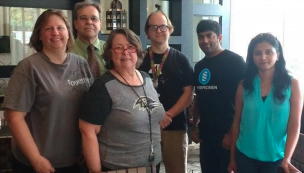
Press Release (ePRNews.com) - PUNE, India - May 16, 2021 (UTC) - Current Adoption Status:
- 67 collection protocols / 40+ active users
- Published 67 peer-reviewed articles
- Supported 20 grants
- Manages 400K specimens for 40K study participants
- 100+K specimens sent to Precision Medicine platform
*Reference: 2019 OpenSpecimen JHU Annual Report
The Johns Hopkins University School of Medicine adopted OpenSpecimen in 2016 as a scalable solution for biospecimen information management.
Key features possible in OpenSpecimen that led to its adoption include:
- Annotation of research and clinical data
- Interfaces with clinical and research systems
- Query capability
- Open-source with a strong user community
- Security
- Specimen and Derivative Tracking
Faculty and IT staff meet monthly in the OpenSpecimen Steering Committee to discuss OpenSpecimen support and future development. A dedicated IT team provides onsite support, augmented by a service contract with Krishagni. The JHU OpenSpecimen team is active in public forums and user meetings, thus supporting new adopters and creating a strong user community.
As OpenSpecimen is open-source, meaningful modifications have been made to the application to serve the JHU user’s needs better. These modifications include a web-service interface with surgical pathology reports. Other projects interface with Epic, REDCap, and the creation of an enterprise login via Shibboleth. Some details of these projects are discussed in more detail below.
History
2008: caTissue piloted by JHU
2011: Evaluation of caTissue v1.2
2013: Upgrade to caTissue Plus v3.0
2015: Adoption of OpenSpecimen v1.0
2016: Upgrade to OpenSpecimen v2.5
Overview of current usage
A variety of specimen collection workflows is supported depending on the needs of the study teams. Study teams initially meet with the Johns Hopkins OpenSpecimen team to discuss the nature of specimen collection (I.e., prospective or legacy) and determine how to best configure the application based on research needs. The application is presented to study teams through an initial demonstration. The study team members are then granted access to an internal Test server instance of OpenSpecimen to become oriented to the application and evaluate draft collection protocols. Recording of legacy specimen collections in OpenSpecimen is facilitated by a data-checker template developed internally, which validates legacy data format for upload to OpenSpecimen.
Implementation details
Implementations and upgrades are performed internally by the Johns Hopkins OpenSpecimen team. Currently, three environments are used to help implement and test OpenSpecimen: Dev, Test, and Prod. Key functionality is tested using a regression test plan. Release notes are developed and distributed internally, highlighting key functionality relevant to the Johns Hopkins research community.
Integration with pathology database
OpenSpecimen is integrated with our pathology database to display the surgical pathology reports (SPR) for research participants. As user permissions in OpenSpecimen are role-based, study team members with appropriate user privileges can view the SPRs for their study participants who have registered with valid Hopkins MRN. This allows the study team to view SPRs relevant to specimens collected & annotated in OpenSpecimen with custom forms.
Integration with Epic
Manual data entry can introduce data entry errors. We have created a real-time interface with Epic to mitigate these errors and support matching OpenSpecimen data with clinical data. It will make a web service call to Epic to fetch the demographic data. This data is stored in OpenSpecimen in a “read-only” manner to prevent editing in OpenSpecimen.
Reference:
https://www.openspecimen.org/johns-hopkins-openspecimen-adoption-years/
https://ictr.johnshopkins.edu/wp-content/uploads/2019-OpenSpecimen-Final.pdf